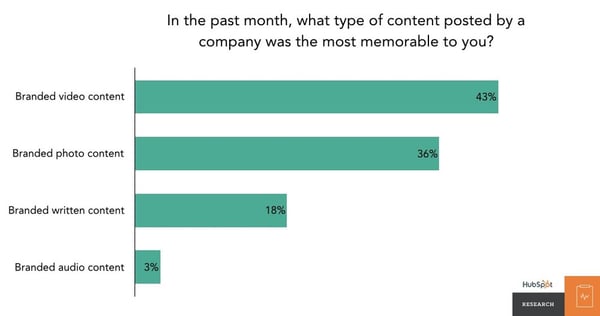As a content marketing agency, we spend a lot of time with our clients thinking through content strategy. One of the biggest questions that come up is what type of content should we produce.
With so many different content formats available (blogging, images, pillar pages, videos, white papers, etc.), deciding where to spend your time and money can easily become overwhelming.
But one content format we continually come back to is video. Even though the video may seem a little more daunting than some of the others, we highly recommend that you give it some consideration for 2018. Here are 5 reasons why:
1. It’s the Consumer Preferred Business Content
Let’s face it, there is already A LOT of content on the Internet. Content marketing is no secret and many great companies are becoming content-producing machines. Whether it’s simpler pieces like blog posts or more in-depth content like eBooks, consumers have countless options at their disposal. So, as a business competing for a consumer’s attention among a sea of content, you must present your content in formats that consumers prefer.
Make no mistake about it, consumers prefer video content. According to a report from HubSpot, 54% of consumers want to see videos from brands they support in comparison to email newsletters (46%) or social image (41%) based content.

From a qualitative standpoint, these stats make sense. In a day and age where people’s attention is constantly grabbed by visual images (Instagram, Snapchat, Pinterest) who wants to read text anymore? I remember the days in school when we’d get excited to watch a documentary on VHS (did I just date myself?) instead of reading a textbook. Fast forward to today (no pun intended), and the comparison is no different when it comes to blog posts and digital videos.
2. Video is More Memorable than Text and Images
According to Hubspot, video content is the most memorable format for web content (43%) in comparison to text (18%) and images (36%). Outperforming text nearly 2 to 1, it's clear that video not only grabs attention, but its message is also more likely to be remembered.

This all could be due to an overload of daily written information. Every day we read and write emails, message on Slack, and communicate through countless text messages. It's been ingrained in daily life to read and write, whether it's for work or personal. With this monotony, it's inevitable that all this stuff will start to blend together.
The message here is clear, if you want your content to be memorable, find a way to put it in video form. At Tobe Agency, we take a hybrid approach to video and written content. Pieces of written content (and in some cases audio content -- like podcasts) are often paired with a summary or short intro via video clip. Using a video as a “teaser” helps create even more interest in reading the blog post, as well as helps us with our next reason why you need a video in your 2018 content marketing strategy.
3. Video Drives More Organic Traffic
In regards to organic social media traffic, it's no secret that Facebook prioritizes organic reach for video content. Social networks like Facebook, Snapchat, and YouTube are quickly becoming the new ABC, CBS, and NBC of the world. But to keep this trend going, they need to incentivize content creators to produce video content. In fact, as recently as December 2017, Facebook noted that it would start prioritizing shows that were developed specifically for its new platform, Watch. This means that the shorter videos that may not provide a lot of value will get deprioritized (sorry viral cat videos) and the videos created with original content will be handsomely rewarded with an increase in organic reach.
So what does this all mean for you? If you’re going to invest in video in 2018, focus your video marketing strategy should on developing longer-form, in-depth video content (4-5 minutes long).
4. Video Helps You Better Explain Your Product/Service and Company Brand
If a picture is worth a thousand words (or a long-form blog post), then a video is worth some order of magnitude more. One of the strongest advantages of using video is the ability to tell a story or explain a product or service in a much shorter period of time, and complex topics are communicated with much greater clarity. A perfect example is the “Explainer Videos” that have become extremely popular on platforms like YouTube for this exact reason. Take a look at one of our favorite explainer videos:
Yes, it’s a video about selling $1 razor blades, but do you think you’d be able to convey the humor, sarcasm, and overview of the product on a company “About Us” page on the website? These intangibles not only explain what the company does but also keep the viewer engaged and more connected to the brand.
5. There’s Never Been a Better Time to Create Your Own Video Content
No doubt about it, video production has become a lot easier for today’s content production teams. With the release of smartphones like the iPhone X, you can now shoot high-quality 4K videos. And tools like the DJI Osmo provide smooth shooting and stable video while on the go. With these readily available options, shooting quality content no longer requires an investment of at least tens of thousands of dollars.
This is especially important for social media content, where you don’t need to produce a cinematically beautiful video to capture people’s attention. In fact, the videos often perceived as more authentic and relatable are also more simple and less produced.
It has also never been easier to distribute your video content at scale. Before the evolution of smartphones with 4G/LTE capabilities, as well as advances in compression technology, the best we could do with slower mobile internet was to read plain text and view pixelated images. With the proliferation of video hosting sites like YouTube and Vimeo, content creators now have a place to easily host video and share it with the masses.
We hope we’ve made a solid case as to why video should not be overlooked in your 2018 content marketing plan.
Are you considering incorporating video into your content strategy? If you’re not, we’d love to hear what’s holding you back!
.png)

-1.png)
.png)